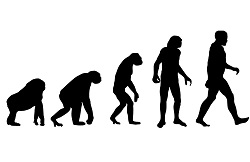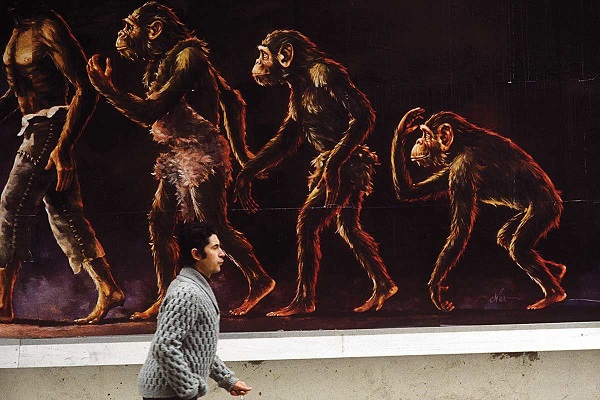 Everyone knows we came out of Africa. Yet at one stage, many millions of years ago, our ancestors disappeared from Africa, but remained in Europe. Then Europe emptied out back into Africa. Some of the key traits that make us human such as big brains, dexterous hands, erect posture and a long childhood developed in Europe and were then taken back to Africa.
Everyone knows we came out of Africa. Yet at one stage, many millions of years ago, our ancestors disappeared from Africa, but remained in Europe. Then Europe emptied out back into Africa. Some of the key traits that make us human such as big brains, dexterous hands, erect posture and a long childhood developed in Europe and were then taken back to Africa.
Apes started their journey in Africa about 26 million years ago.
- Between 20 and 7 million years ago, Earth really was the planet of the apes. At least 100 species roamed the world before the first humans appeared.
Now there are just seven great apes, or hominids (two each of gorillas, orangutans and chimpanzees, plus us), along with 16 lesser apes.
The oldest apes we know of in Europe were from the genus Griphopithecus, dating from 17.5 million years ago. They had robust jaws and teeth, adapted for powerful crushing and grinding, and hence the capacity to eat a wider variety of foods, so they could expand their range out of Africa and into Europe and Asia.
Meanwhile between 14 and 8 million years ago, apes became rare in Africa, and the species that stayed were bound for extinction.
Around 12.5 million years ago, in Catalonia, northern Spain, the first ape with a more upright posture appeared. Pierolapithecus, sometimes called Dryopithecus, had:
- a more vertical backbone, a broad chest, arms longer than legs, very mobile wrists, and long, curved, powerfully grasping fingers. These features made Dryopithecus look more like today’s great apes. They also indicate a major transition from walking like a monkey on all fours to ape-like movement, hanging and swinging below branches.
Then:
- Hispanopithecus, living in what is now Catalonia a few million years later, had longer arms and an even more upright back. So did Rudapithecus, its contemporary in what is now Hungary. More significantly, to our knowledge Rudapithecus is the first ape to evolve two other key features of modern great apes – a big brain and extended childhood.

Apes had colonised Europe during the warmest phase of the Miocene, when Europe was sub-tropical, but by 14 million years ago the climate stared to cool. The theory is that as Europe cooled apes successfully adapted to the harsher environment.
- Big brains and extended childhoods are associated with higher levels of intelligence, memory, complex learning and strategic thinking, important tools for apes living in challenging seasonal environments – and characteristic attributes of our own species.
Adaptation could only go so far, and about 10 million years ago, European apes headed back to Africa, where with their enhanced capacities, they prospered. About 7 million years ago in Africa we branched off from the chimpanzees.
Somewhere along the line we lost the strong bite and developed more flexible lips and mouths, a thinner neck and an even bigger brain. The combination was necessary to develop language.
We used to think that our species, Homo sapiens, a mere 200,000 years old, came out of Africa about 60,000 years ago. Now this has been pushed back to 100,000 years by studying Neanderthal DNA which contains some of ours. The full effect of the gene interchange is another story, but from us they gained the FOXP2 gene which is associated with language. As yet we don’t know whether its expression in Neanderthals enabled them to talk. From them we got good and bad, including in some cases about a 2 per cent increased chance of developing depression, a 1.4 per cent increased risk of a heart attack and a slightly higher susceptibility to nicotine addiction.
The earlier grand tour of Europe was the important one, however. Without the developments that happened in Europe, humans would never have evolved to what we are today.

Thanks Brian for some really interesting perspectives. Amazing how much we can learn from the analysis of minute traces of DNA.
‘Can’t help wondering if one day there might be insights into human moral development.
I’ve just started reading Sapiens by Yuval Noah Harari and thanks to him I’ve discovered that all of the fossils which I thought were our ancestors (such as Neanderthals and Denisovans) were in fact separate species; a point that the linked articles reinforce.
The book is highly recommended by people whose opinion I trust.
Gee, I thought I knew everything about the rise of the Primates. (so I’m over thirty years out of date, it seems). 🙂
Miocene influences are interesting. So, too, the European factors. So then there’s more to non-African prehistory than the Chuk’outien (Zhukoudian) discoveries?
Zoot: Thought that if Neanderthals and Denisovans were separate species then progeny with other hominids would be mules – and, clearly that is not the case. Wonder what other branches of the hominid tree will emerge from extensive DNA studies of non-urban Africans (both living and long-dead)?
Geoff H. : Don’t we already have a few glimpses into human moral development? The more the merrier though.
GB – so did I, but apparently not, since a tiny percent of some Sapiens DNA is Neanderthal or Denisovan. A lucky few couples must have had fertile progeny, I presume before the species became irrevocably separate.
Evolution fascinates me – it’s much more subtle than I was taught.
zoot, I wasn’t ever taught biology, so it’s all new.
Enjoy Yuval Noah Harari! I did a post Charting the progress of Sapiens in January last year, with some links to reviews. You might prefer to read it yourself before reading what others say about it.
Geoff, for insights into human moral development, as it happens New Scientist has a review of Michael Tomasello’s Natural History of Human Morality. There’s another in The Atlantic.
I think we’ve got a bit too much chimp in us. They can be very violent, unlike their sister species the Bonobo, where females run the show.
Capuchin monkeys have a sense of fairness that can lead to them doing things that they don’t have to do. Morality goes back a long way.
Patriarchal theory – a la Darwin’s theory of evolution – is not necessarily wrong, and it may contain many insights – it’s just always oversimplified.
It’s never just about the genes – it’s always about how the genes interact with the environment, including the prenatal environment. Theorists like Darwin were wedded to the idea of men as active, women as passive, and it was hard for them to move beyond that – thus they thought that the only way change could come about was by change to the ‘seed cells’, rather than seeing change as an interactive process.
The whole excursion into Europe during the Miocene was new to me.
Graham, I’m not sure there is a general rule about interbreeding of species.
Val, I was reading Erich Hobsbawm on Europe in the 20th century and was impressed that girls and women figured so little in public life in the 19th century. Even their appearance in secondary schooling was rare.
People may have heard of The Seven Daughters of Eve, Bryan Sykes notion that all Europeans are descended from just seven women, our clan mothers, who didn’t necessarily live at the same time.
Seems that later people have found a few more to make up to 18.
There’s a simple account here, and more here.
Val, s an agnostic feminist, I always enjoy your contributions here and elsewhere.
Just yesterday in an ‘Invasion vs Settlement’ FB debate, a ‘strait’ zoologist lectured about “I am glad I studied Zoology, much less controversy there. History is a fickle subject.”
I politely suggested that in my understanding of zoology I could come up with a handful of major riddles nature spins in his chosen field ( yep ,evolution and human origins were on my list). Also if he would have bothered to inform himself with the relevant background before commenting authoritatively on a delicate historical subject, he wouldn’t consider it “fickle” and actually could contribute to the discussion rather than heckling from the back seat.
Now if the above “fickle” thinking represents patriarchy , then I totally get it and I am over it. Is there a gene for “fickle” thinking or is it learned 🙂
Yep, what an amazing journey and what surprising ancestry. Like Graham, I thought to be reasonably up to date, but not so. The moral development question is an interesting one and is increasingly become more pertinent with the kind of ‘limits’ we are rapidly approaching. I have looked at the Bonobo societies and studies done in communities which where female based, fostering inclusiveness, diversity or if you like, “stability” in contrast to the above “fickle”. Val, I wonder if you know of these female based societies, could you please share that with us i have lost the reference, thank you.
Thank you very much Brian for your blogging effort and for sharing a wealth of information and a stimulating discussion.
Cheers Ootz
Ootz, what a pleasant surprise! Thankyou!
Val comes and goes and may respond. I’d half planned to do a post at one stage on a matriarchal group somewhere between Tibet and China. The male partner of a couple never leaves his own family. The progeny are raised by the mother and her male relatives.
They were poor, though, and their society was being distorted by the impact of tourism and young people leaving. I’ve forgotten the name and lost the links.
I’ve also heard of a matriarchal society, where the men are Arab gulf traders, away on their boats a lot.
Third and last was the first nations peoples of what is now NE USA where females ran the tribes and they had above that a kind of group multi-nations parliament made up of men, but could be recalled by the female tribal leaders.